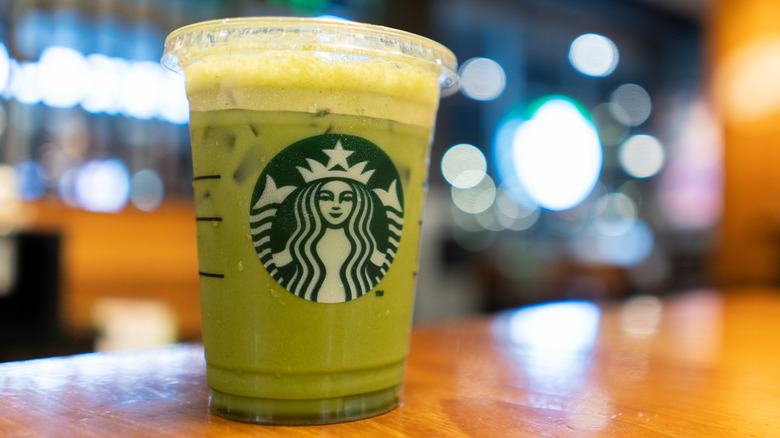The Matcha Starbucks Uses Is A Far Cry From The Real Thing
If you talk to a Starbucks barista about how to make a matcha latte, they'll tell you that no sweetener is added to the drink. Yet anyone who's ever tasted Starbucks' matcha latte knows it's a sweet beverage. According to the Starbucks website, the reason for this is that the matcha powder used in their lattes already contains sugar. In fact, sugar is listed as its first ingredient, making up over half of its composition. Matcha tea, in its pure form, has no sugar.
The flavor of matcha may be an acquired taste for some. It's somewhat grassy-tasting and slightly bitter. For the hardcore tea aficionado, matcha, as it's intended to be served, differs significantly from Starbucks' offering. Matcha is a traditional Japanese powdered tea first enjoyed by Buddhist monks in the 1100s. While matcha is considered a green tea, it's different from other green teas. There are several differences between the two types of tea, including their taste, color, and how they're grown.
Quality matters when it comes to matcha
There's a scientific reason matcha has such a vibrant green color. The tea plants used for matcha are cultivated in the shade for the last part of the growing cycle before harvesting. This slows the plant's growth and allows the chlorophyll inside the leaves to build up. The more chlorophyll, the more vivid the color.
There are differences even among matchas. The lower-grade culinary matcha — the kind most likely used in the Starbucks powder — will do if you plan on using it in cooking or baked goods to add flavor and a distinctive bright color. But, to get the full experience, look for a ceremonial-grade matcha.
Using a high-quality tea is essential to experiencing the full flavor. This is another way Starbucks falls short of providing an authentic matcha beverage. Starbucks buys its matcha in bulk to add to the powder when tea experts say the tea should be purchased in small batches to ensure quality, as it will begin to lose flavor as soon as it's opened.
Make your own matcha latte at home
Making a matcha latte at home allows you to control the ingredients that go into the drink. A basic recipe for a matcha latte made with almond milk will let the tea's taste take center stage, with only a touch of sweetness added to offset any bitterness. Better flavor and quality aren't the only benefits of foregoing those Starbucks runs. While a Starbucks Matcha Latte will run you a little over five dollars for 16 ounces, making one at home using ceremonial-grade matcha will only cost around $3.50.
A cup of matcha is very simple to make. First, the tea is sifted into a tea bowl, and water heated to just below the boiling point is added. The mixture is then stirred with a bamboo whisk to remove lumps and create a froth. That's all there is to it. Your matcha can then be enjoyed straight from the tea bowl.
Many people have replaced their daily cup of coffee with matcha for a change of pace and to take advantage of its unique health benefits. One of those comes from an amino acid present in good-quality matcha. This amino acid, called l-theanine, has been shown to improve cognitive function. Couple that with matcha's 70-100 grams of caffeine – similar to a serving of coffee – and you're looking at a great way to stay alert and focused, no sugar required.


